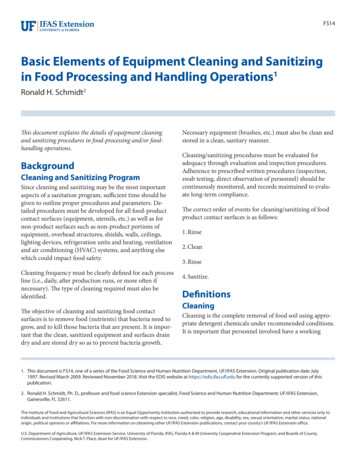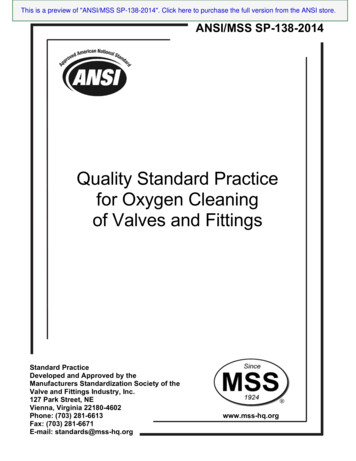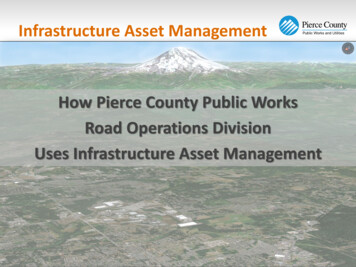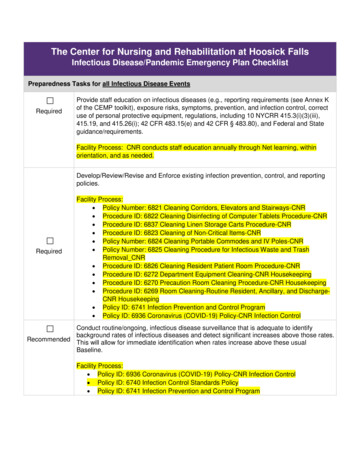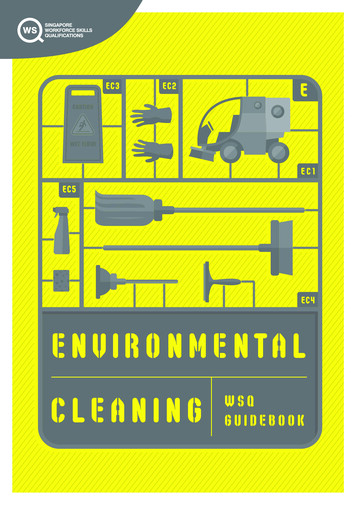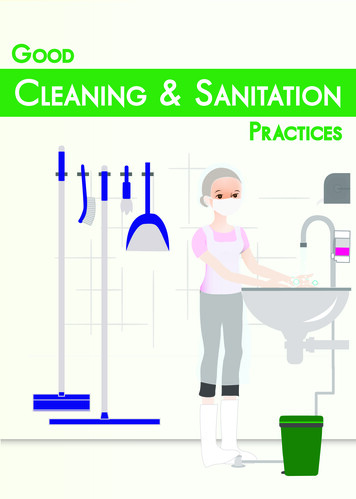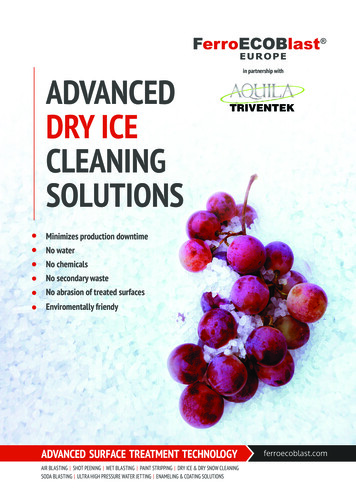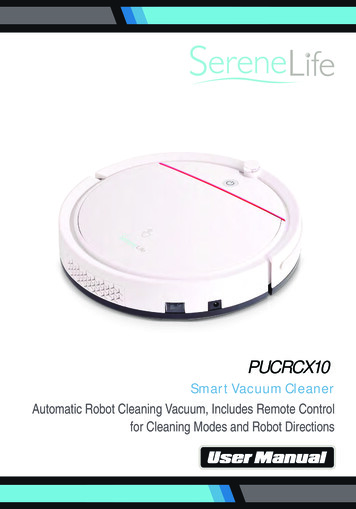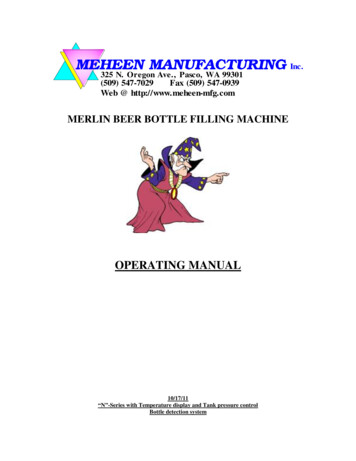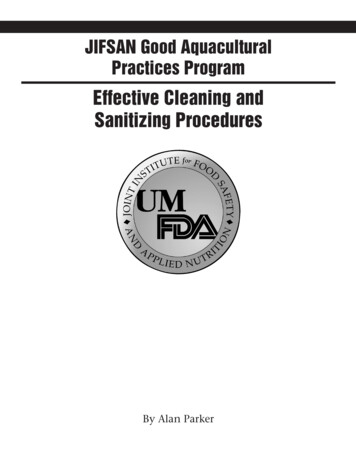
Transcription
JIFSAN Good AquaculturalPractices ProgramEffective Cleaning andSanitizing ProceduresBy Alan Parker
JIFSAN Good Aquacultural Practices Manual Section 9–Effective Cleaning and Sanitizing ProceduresWhy Is Effective Cleaning andSanitizing So Important?Effective cleaning and sanitizing helps protectthe health of the animals by controlling thetransmission of animal diseases. It controls humanhealth by preventing transmission of humandiseases in foods. Cleaning and sanitizing helpsprevent pest infestations by reducing residues thatcan attract and support pests. It also improves theshelf life and sensory quality of food products.Effective Cleaning and SanitizingEffective cleaning and sanitizing is done byidentifying areas and items to be cleaned. Then,effective chemicals and application methods mustbe selected. Clean is competed first, then sanitizingis done in 2 steps. You should perform CandSregularly, and validate that the program has beenperformed correctly.What Should be Cleaned and Sanitized?All surfaces that may contact the food product,such as utensils, knives, tables, cutting boards,conveyor belts, ice makers, ice storage bins, hands,gloves, and aprons. Surfaces that do not directlycontact the product such as walls, ceilings, floorsand drains have a profound effect on environment.What Else Should be Cleaned andSanitized?Cleaning tools like brooms, mops, squeegees,buckets, sponges, scrapers, foaming equipment,water guns, etc., should be cleaned and sanitized.Cleaning tools can be a major source of microbialcontamination if not cleaned. Cleaning toolsshould be washed and sanitized after every use.They should be stored clean, dried, and secured.The Cleaning StepCleaning is the complete removal of unwantedmatter using appropriate detergent chemicals underrecommended conditions. Cleaning personnel needa working understanding of the type of substancesto be cleaned the basic chemistry of its removal. Aswe will see later, cleaning and sanitizing need to beperformed in two separate steps. It is impossible tosanitize a surface that is still dirty. There must bean effective rinse after the cleaning step to removedetergent residue that can interfere with the actionof chemical sanitizers.Characteristics of Food SoilsSoil is any unwanted matter on the surface of anobject that one desires to be clean. Cleanliness isan unnatural condition, because all surfaces areconstantly being soiled. Special care must be takento ensure that all soil is removed and that it is notredeposited on the substrate.Soil may be classified as visible and invisible, thelatter category being primarily microorganisms,such as bacteria, yeasts, and molds.Soil is best identified by characteristics that giveinformation on how it may be dissolved, becausethe object of cleaning is to dissolve or to suspendsoil and then to wash it away.Some food soils can be dissolved in water suchas simple carbohydrates (sugars), some simplemineral salts (NaCl), and some starches. Thereare also food soils that dissolve in alkali, likeproteins, starches associated with proteins or fats,and bacterial films (biofilms). There are food soilsthat dissolve in acid, like hard water hardness salts(calcium and magnesium salts), and more complexmineral films, including iron and manganesedeposits. Finally, there are those that dissolve withsurfactants, which include fats, oils and greases,many food residues, inert soils such as sand, clay,or fine metals, and some biofilms.What are Biofilms?Biofilms are a collection of microorganisms, mainlybacteria, growing together in a matrix of polymerssecreted by the microorganisms. Once microbesCopyright 2007 University of Maryland and the JohnsonDiversey Corporation. This work may be reproduced and redistributed,in whole or in part, without alteration and without prior written permission, for nonprofit administrative or educational purposesprovided all copies contain the following statement: “ 2007 University of Maryland and the JohnsonDiversey Corporation. Thiswork is reproduced and distributed with the permission of the University of Maryland. No other use is permitted without expressprior written permission.” For permission, contact JIFSAN, University of Maryland, Symons Hall, College Park, MD 20742.
grow into well-developed biofilms, cleaning andsanitation become much more difficult. Biofilmshave a shielding effect on the bacterial cells withinthem, and normal cleaning and sanitizing methodsmay not eliminate them. Biofilms MUST beremoved or prevented from forming on surfaces.Disease-producing bacteria, including Listeria, canbe 1,000 times harder to eliminate if it is living ina protective biofilm. Biofilms can be very difficultto remove from surfaces, and are known to havean increased biocidal resistance due to the biofilmstructure protecting the microorganisms. Biofilmscan be a continual source of pathogenic andspoilage organisms if not completely removed.What are Biofilms?A collection of microorganisms, mainly bacteria,growing together in a matrix of polymerssecreted by the microorganisms.ColonizationWater comprises approximately 95-99%of cleaning solutionsWater’s many functions in cleaning:Pre-rinse, to remove gross soilsSoften soils left on the surfaceCarry detergent to the surface to be cleanedCarry wastes away from thesurface being cleanedRinse detergent off of the surfaceWater quality, particularly its mineralhardness, can drastically alter theeffectiveness of a detergent.Water HardnessBiofilm Formation:AttachmentWater – Cleaning FunctionSurface CleanersGrowthSurfactants Make Water WetterBULK FLUIDA surfactant (surface active agent) is a substancethat lowers the surface tension of a solution.Surfactants also foam, emulsify, and disperse soilsin solution. Surfactants have anionic, cationic. ornonionic (neutral) chemical structures.Planktonic CellsSessile CellsS U R FA C E MSU-CBEP. D i r c k xWater AloneCourtesy of MSU Center for Biofilm EngineeringSpoilage organisms such as Pseudomonas growin biofilms and can be sloughed off duringproduction, contaminate the food, and acceleratespoilage. The polymers secreted by the bacteriaclose to the surface are strong adhesives makingthe cells very difficult to remove. The cells in abiofilm actually take on specialized functionsand can communicate with each other in arudimentary way (called Quorum Sensing).Organic ‘soilSolid substrateWater SurfactantWaterCalled the universal solvent, water is the basis forall surface cleaners. Water is a good solvent—byitself it has the ability to clean many soiledsurfaces. Cleaning with water alone is the yardstickby which we measure the effect of cleaningchemicals. Other active ingredients are addedto enhance the effect. Detergents aid water inremoving soil.9- No wetting of soils on surfaceWetting occurring withwater plus surfactantSoil within water dropletWETTED SOILSolid substrateCopyright“ 2007 University of Maryland and the JohnsonDiversey Corporation.
Application of CleanersDetergent or Cleaning AgentBoth soaps and detergents help water to emulsifyfats and to suspend solid soil particles. Soapsare made from fats and lye, while detergents aresynthetic chemicals. Soaps and detergents actby reducing the surface tension of water, whichincreases water’s interaction with soils, surroundsand lifts the soil from the surface, and allows waterto flush the surrounded soils away. Proteins willhydrate and swell when they come into contactwith water, which helps alkalis to react with them,forming soluble salts.Manual CleaningEquipment manually disassembledHand scrubbing and washingSemi-automatic OPCHigh pressure washing and rinsingFoamingMechanical (Clean-in-place or CIP)Automated cleaning processManual CleaningPads, brushes and brooms should be:Characteristics of a Good Detergent1. Dedicated to tasks for which they are designed.Rapid and complete solubility in water Optimizes cleaning effectiveness; andGood swelling of soil Minimizes cross-contamination betweenareas of the plant.Good wetting capability of surfacesGood dispersion and suspension properties2. Designed for the task.Good rinsing propertiesNon-corrosive to surfacesNon-toxicCost effective Brushes—proper stiffness; Pads—proper cutting properties; and Pressure spray—moderate pressure. Cleaning aids that retain water, such assponges, wiping cloths, and mops shouldnot be used for routine cleaning.3. Do not mix uses. For example, never:Surfaces and Cleaning SubstancesTYPE OFSURFACERECOMMENDEDCLEANING SUBSTANCEStainless steelAlkaline, not abrasiveAcid, not abrasiveUse floor brooms / floor squeegees on tables Use green pads used for cleaning wastebarrels on grading or packing tables Use the same brush to clean floors on anyfood contact surface.FREQUENCYOF USEDailyWeeklyMetals (copper,aluminum,galvanizedsurfaces)Moderately alkalinesubstances with corrosioninhibitorsDailyWoodDetergents withsurfactantsDailyRubberAlkaline SubstancesDailyGlassModerately alkalinesubstancesDailyConcrete FloorsAlkalineDaily9- High Pressure Washing Useful for walls, floors, large equipment andtables. Spray can form aerosols mist from irritatingchemicals. Atomization can spread soil andmicroorganisms. Pressures used: Low Pressure: 15 bar Medium Pressure: 15 to 3 barCopyright 2007 University of Maryland and the JohnsonDiversey Corporation.
High Pressure: 30 to 150 barRecommended: 45 bar.Foam Cleaning - Cling TimeFoaming Techniques Pre-rinse to remove loose soil and residues. Foam up, rinse down. Work in small sections. Allow foam to remain on surface 10 to 15 min. Be aware of surfaces susceptible to corrosion. No advantage in foaming hot solutions. Wear protective equipment (goggles, gloves,suit and boots).Automated Cleaning (CIP) Clean-in-place: Cleaning internal surfaces ofproduction equipment without disassembly.9- Tanks, heat exchangers, pumps, valves,pipelines, and other enclosed surfaces. Cleaning solutions contact the surfaces bypumped circulation and automatic spraying.Copyright 2007 University of Maryland and the JohnsonDiversey Corporation.
Contrary to manual cleaning, can use highchemical concentration and temperature.2. Sanitizing Food ContactSurfacesSanitizing is a procedure to treat food-contactsurfaces that destroys most disease producingbacteria and viruses, substantially reduces thenumber of other undesirable organisms, and doesnot adversely affect the product or its safety forthe consumer. Sanitizing can be done with heat orwith chemicals.Sanitizing does not affect bacterial spores—that isbeyond the capability of the process. A sanitizerwill not sterilize a food-contact surface or awater system. Sterilization refers to the statisticaldestruction and removal of all living organisms,including spores. The official definition ofsanitizing for food product contact surfaces is aprocess which reduces the contamination levelby 99.999% (5 logs) in 30 sec. Disinfectants arestronger chemicals that produce a much largerreduction of microorganisms. They are generallynot used in food applications.Thermal SanitizingSteam Limited application Expensive Difficult to regulate Difficult to monitor contact time andtemperature It is a physical hazardFor a sanitizer to be effective, the surface beingsanitized must be physically clean. One cannotsanitize a dirty surface—organic soils will consumethe sanitizer. Detergent residues must be rinsedwell—they will neutralize many sanitizers.Detergents are alkaline, most sanitizers are acidic.Detergents have negative charge, sanitizers havepositive charge. Spraying a surface with a sanitizingsolution without first cleaning the surface properlyis a waste of time and money.Chlorine-based SanitizersThe most commonly used sanitizers in foodapplications are chlorine gas, sodium or calciumhypochlorite, and organic chlorine (SodiumDichloroisocyanurate). All form hypochlorousacid (HOCl, the most active form) in aqueoussolution. The activity of chlorine is affectedby pH. Temperature destabilizes chlorine., andchlorine is rapidly inactivated by organic matter.Corrosiveness to surfaces is a major disadvantagewhen using chlorine, and high temperatureincreases the risk of corrosion. Chlorine is lessaffected by water hardness when compared toother sanitizers. Chlorine has some advantagesand disadvantages, as do all types of sanitizers.The principal disadvantage of most chlorine-basedsanitizers is instability. They are affected by theacidity of the water in which they are diluted.Broad-spectrum Germicides.Hot water 80-85 C, for 30 seconds Easy to apply Effective Non-corrosive High energy costs Safety concerns9- Prepare a Surface for SanitizingThe term “Broad Spectrum” when applied to asanitizer means that it will attack a wide varietyof different types of microorganisms, includinggram-positive bacteria (Listeria and Staphylococcus),gram negative bacteria (E. coli and Salmonella),viruses, fungi (both yeasts and molds), as well asmany parasites. Broad-spectrum germicides act onmicrobial membranes, cellular enzymes, DNA, andprotein. Iodine-based sanitizers have been usedas antimicrobial agents since the 1800s and havea broad spectrum of activity They are a powerfulsanitizer in strong acidic aqueous solutions. Theyare generally used at 12.5 to 25 ppm availableiodine, and can cause staining on some surfaces,especially plastics.Copyright 2007 University of Maryland and the JohnsonDiversey Corporation.
Other SanitizersMethods of Applying SanitizersQuaternary ammonium compounds (Quats)are cationic surfactants. They have fair wettingproperties and react strongly with cell walls ofcertain microorganisms. Quats are more effectivethan chlorine against yeasts, molds and grampositive microorganisms like Listeria monocytogenes,but less effective against gram-negative bacteriasuch as coliforms, Salmonella, and E. coli. Quats areincompatible with soaps and anionic detergents.Most cleaners are anionic, so surfaces must bethoroughly rinsed between cleaning and sanitation.Quats are excellent environmental sanitizers forfloors, walls, drains, and equipment. They are noncorrosive to metals and stable at high temperature,but highly affected by water hardness.Working With Concentrated ChemicalsRecommended Use Levelsfor QuatsWalls & Ceilings for Mold2,000 – 5,000 ppm*Equipment Sanitizing200 ppmFloors & Drains800 ppmFloor Mats1,800 ppmFoot Baths2,400 ppmNo Rinse 200 ppmAcid-anionic sanitizers are surface-active sanitizers,but negatively charged. Formulations includeinorganic and organic acids plus a surfactant.Carboxylic acids (fatty acids) are some timesincorporated as well. They are unaffected by hardwater or organic soils. The dual function of acidis that it can be used for rinsing and sanitizingin one step. These sanitizers must be used at lowpH. Activity above pH 3.5–4.0 is minimal. Acidity,detergency, stability, and noncorrosiveness makesthem highly effective. Acid-anionic sanitizersare broad spectrum against bacteria and viruses,but not very effective against yeasts and molds.Peroxyacetic acid (PAA) is an equilibrium mixtureof acetic acid and hydrogen peroxide in anaqueous solution. It is a very strong oxidizingagent and has a stronger oxidation potential thanchlorine. It has a pungent acetic acid odor, andcan be used to control odor and biofilms from foodcontact surfaces, and as a microbial control agentfor sanitizing surfaces of equipment, floors, walls,and indoor processing and packaging facilities.9- Follow label instructions carefully. Always store concentrated chemicals in originalcontainer. Work with proper dilutions. Wear protective equipment recommended bymanufacturer.Cleaning and Sanitation Basic Steps Flush or sweep surfaces to remove gross soil. Wash the surface with the appropriate cleaningcompound. Flush the cleaner from the surface. Apply a sanitizer. Flush the sanitizer.Sanitation Standard Operating Procedures SSOP is a written document. Describes chemicals, concentrations,application methods and timing for every partof the plant. Master Sanitation Schedule: What, When,Who? Cleaning and Sanitizing Procedures: How? CandS Records: Shows that procedures andschedule were followedCleaning and Sanitizing Validation Cleaning and sanitizing procedures should beregularly monitored for effectiveness. Pre-operational inspections or audits Microbial sampling of the environment orof food contact surfacesEstablish criteria to be met No visible residue present Micro counts within acceptable limitsValidation Methods What everyone can do: Visual Inspection (Best Verification Method)Copyright 2007 University of Maryland and the JohnsonDiversey Corporation.
Surface appearance: visible debris, soilbuild-up, color of equipment surface (whitefilms, stains, etc.), biological growth (i.e.,mold) and odorUse simple tools: Eyes Nose Flashlight Scraper Common SenseTypical CorrectionsObservation: Sanitizer concentration fromdispenser varies day to day.Correction: Repair or replace chemicalproportioning equipment and train cleaningcrew in its proper use.Observation: Juncture of two table tops trap fooddebris.Correction: Separate tables to allow access forcleaning.Observation: Table work surfaces show signs ofcorrosion.ConcentCorrection: Refinish or replace damagedequipment and switch to less corrosivecleaning compound.eTimrationCleaning and Sanitizing ValidationratureeTemp9- MechanicalForce Right chemicals and concentrations Application time Solution temperature if applicable Mechanical force or actionCopyright 2007 University of Maryland and the JohnsonDiversey Corporation.
Manual Cleaning Equipment manually disassembled Hand scrubbing and washing Semi-automatic OPC High pressure washing and rinsing Foaming Mechanical (Clean-in-place or CIP) Automated cleaning process Manual Cleaning Pads, brushes and brooms should be: 1. Dedicated to tasks for which they are designed. Optimizes cleaning effectiveness; and
